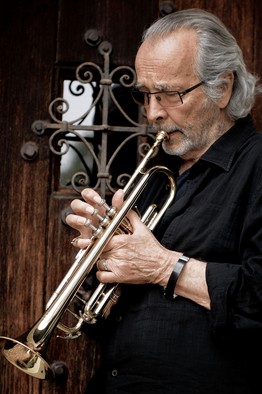HERB ALPERT READIES NEW ALBUM

At the end of 1965, Herb Alpert went head to head with Bob Dylan and the Beatles. His album, “Whipped Cream & Other Delights” with the Tijuana Brass, climbed past “Highway 61 Revisited” and “Help!” to No. 1 on Billboard’s album chart. In each of the next three years, Mr. Alpert’s albums topped the chart, paving the way for horn-driven pop bands like Blood Sweat & Tears and Chicago.
Mr. Alpert is still at it today. In January he won his ninth Grammy for “Steppin’ Out,” and on Sept. 30 he will release “In the Mood” (Shout! Factory), a jazzy, electronic lounge album featuring his relaxed, after-midnight trumpet. Over the course of his 58-year career, Mr. Alpert co-founded A&M Records and is still the only artist to record a No. 1 vocal (“This Guy’s in Love With You”) and a No. 1 instrumental (“Rise”). Mr. Alpert, 79 years old, talked about his new album and his laid-back style. Edited from an interview:
What’s the theme of your new album, “In the Mood?”
There was no master plan. I just picked songs that popped into my head. I wanted to include two songs to honor the late Phil Everly—”Let It Be Me” and “All I Have to Do Is Dream.” Other than that, these are just songs that have lingered with me or were loops the guys in my band sent along.
A remake of “Chattanooga Choo Choo” might be stretching it, no?
The Glenn Miller song from 1941 just popped into my head and stayed there. A number of people, including my wife, Lani Hall, told me not to record it, that it was too square. But the song felt good and I’ve made a career out of doing what feels good to me. If a song works and it’s honest, people will get it. My interpretation has electronic and Latin elements, so it has a contemporary vibe.
(Read more about ‘Chattanooga Choo Choo.’)
Does it bother you to be thought of as the “king of casual?”
There’s a word called “happy.” I’ve always wanted to be that, and my music and trumpet reflect this ambition. I listened to jazz when I was young, but I have a classical background and studied formally for eight years. I just react to what sounds good and try to stay as spontaneous as possible. I’ve never rehearsed most of the songs I’ve recorded. I have relative pitch, so if I hear a song once, I can play it back instantly. Mostly, I try to be honest and listen to my inner voice.
Who taught you that?
Sam Cooke. I co-wrote “Wonderful World” with Sam and Lou Adler in 1959, and he taught me that a record has to resonate with the soul. Sam also taught me to trust my inner voice. One day he showed me a set of lyrics and asked what I thought. I told him they sounded corny. He picked up his guitar and made that song sound tremendous. Another time we were in the control room auditioning a good-looking guy singing in the studio. Sam asked what I thought. I told him I liked him a lot. Sam told me to turn my back and listen. I found I actually didn’t dig the guy’s voice. That’s why after co-founding A&M, I always auditioned new artists with my eyes closed. It forced me to listen to my instincts, not my eyes.
I met Jerry in the early ’60s. We formed Carnival Records in ’62, but we had to change the name to A&M because Carnival was already taken. Jerry was a great independent record promoter and he was honest. I was very lucky. We’re friends to this day.
Why add the sound of a bullfight to “The Lonely Bull,” your first hit?
When we released “Tell It to the Birds” my first single in ’62, it started selling in L.A. and San Francisco. Dot Records paid me $500 to pick up the distribution, and Jerry and I used the money to record my friend Sol Lake’s “Twinkle Star,” which we renamed “The Lonely Bull.” I played piano and two trumpets on the single and used the drummer from the Ventures. When I played the demo for B. Mitchel Reed, a Los Angeles DJ, he said, “Where’s the hook? It’s an instrumental!” A friend at Liberty Records had a tape of 30,000 people screaming “Olé!” so I added it to the start and end of the record. Jerry got all these independent distributors to work it and the single—our first on A&M—took off, reaching No. 6 on Billboard’s pop chart.
Who came up with the name, Tijuana Brass?
That was Jerry’s idea. I was reluctant. I didn’t want to be an imposter. I never listened to mariachi music and I’m not of Mexican descent. Jerry and I had gone down to Mexico a few times to see bullfights. They had a brass band in the stands that played fanfares, and the crowed went nuts. Jerry thought the Tijuana Brass would be a good name and that we should record pop music with that tight, brassy, mariachi sound. I went along with it under the assumption the Tijuana thing would be for just one record.
In 1968, you recorded “This Guy’s In Love With You.” Why did it work?
You have to start with a great song. I asked Burt Bacharach, a friend, if he and Hal David had a song for me. He gave me this one and wrote the orchestral arrangement. He was even in the studio when I recorded it. I wanted this two-second pause between my vocal and my trumpet solo. Burt said, “Oh, man, you can’t do that. Take it out.” I thought it felt good and wanted to keep it. Burt didn’t think the gap was radio-wise. I thought a pause would be a dramatic and sensitive way to segue from the vocal to the horn. Actually, my vocal on the record was supposed to be the demo, just to see if it was in the right key. But when we listened to the playback, the musicians said, “Don’t touch it.” I agreed.
Was it a mistake to drop the Sex Pistols from A&M after just a week in 1977?
I don’t think so. These guys were ornery. They bought a bad, aggressive energy onto the lot. It’s funny, three weeks ago I was in a Malibu market and I bumped into Johnny Rotten [John Lydon], who looks completely different than he did then and is mellower. He said he’s still making music. He just remembers they were with A&M for a while.
Was “Rise’s” success in 1979 unexpected?
Everything in this business is unexpected. My nephew and producer-songwriter Randy Alpert initially wanted me to turn Tijuana Brass hits into dance records. It just didn’t feel right but I gave it a shot. I brought in musicians and we played down a disco version of a “Taste of Honey.” I couldn’t feel it. Randy had written “Rise” [with Andy Armer] and wanted us to do it at 120 beats per minute—the standard disco tempo back then. But I slowed it down to 100 beats, giving it more of a soulful feel, and it worked.
How do you feel when someone calls your music cheesy?
[Laughs] They’re thinking too hard. Art is a mystery. There’s no way you can figure out what’s special if you analyze it. You either feel it or you don’t. The definition of art isn’t breaking your neck. Why would you do that? Honesty and passion are everything—at least they are for me.
